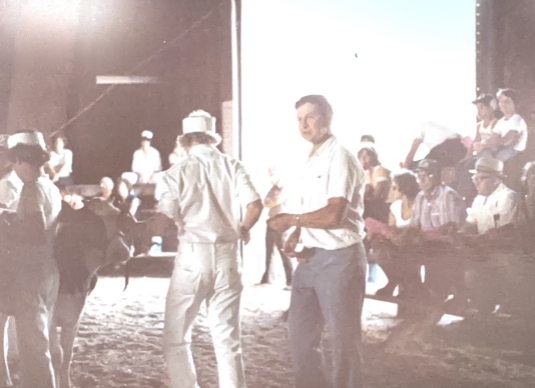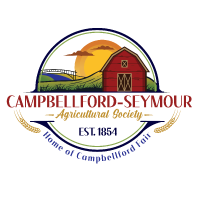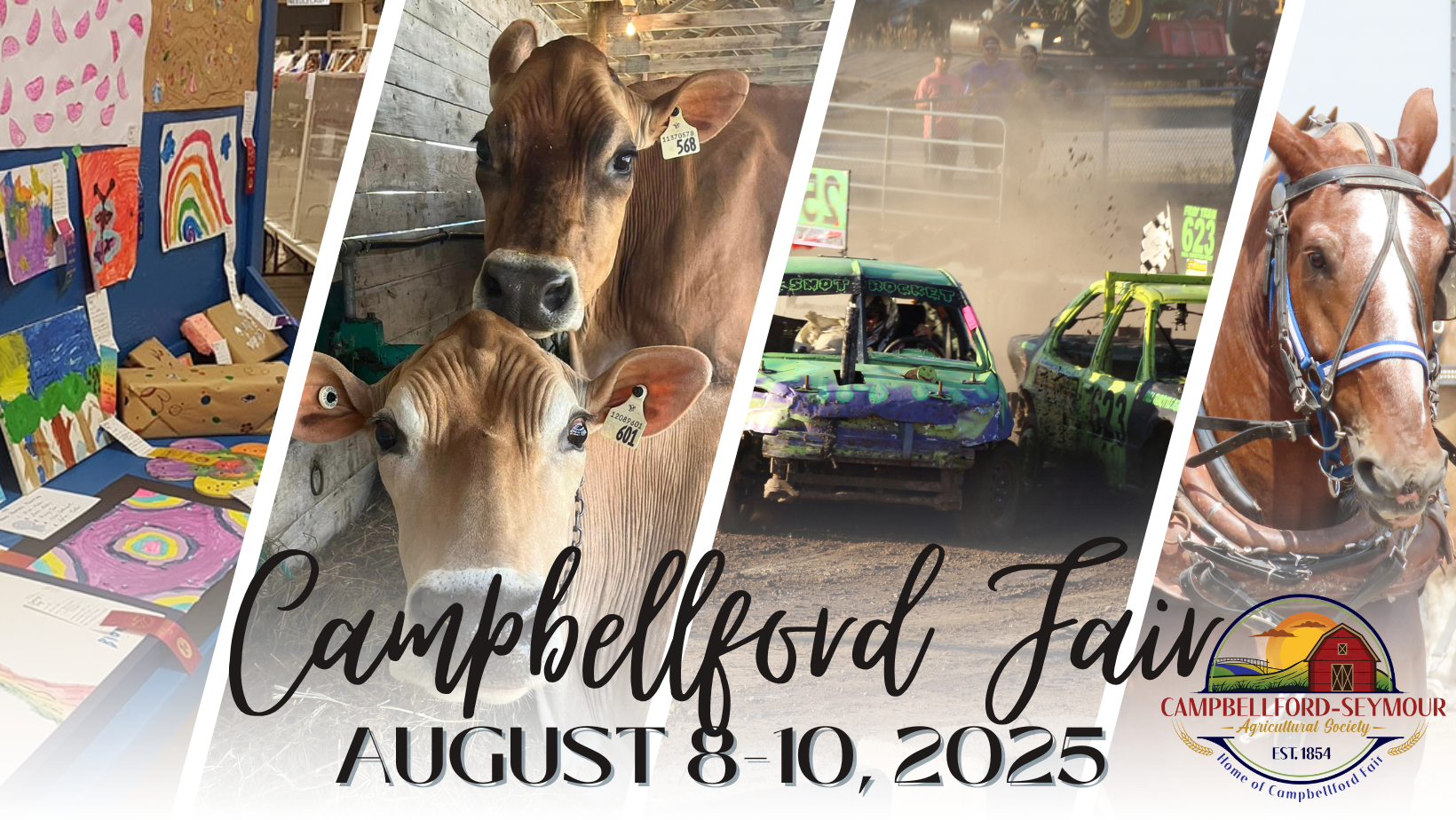
WELCOME
The Campbellford-Seymour Agricultural Societies goal is to promote a positive image of the agricultural industry, while fostering a sense of community and fellowship, in celebration of our rural heritage.
CAMPBELLFORD FAIR
AUGUST 8th- 10th
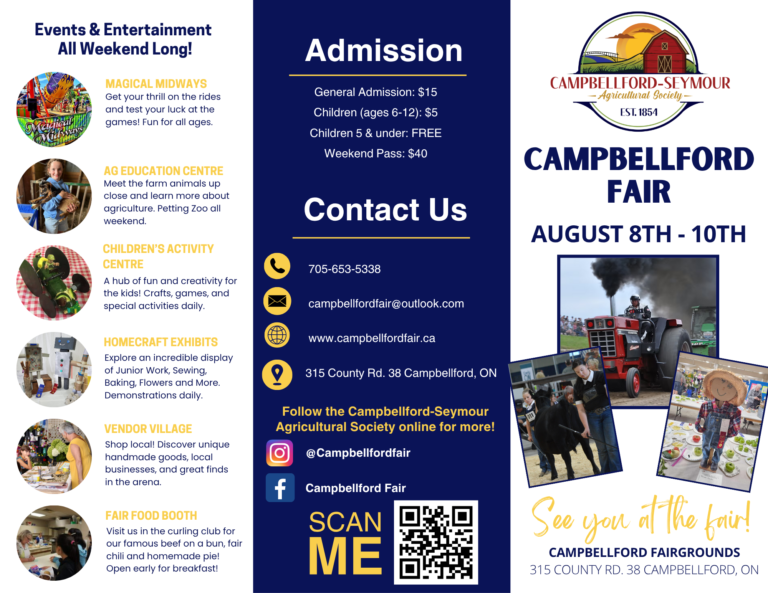
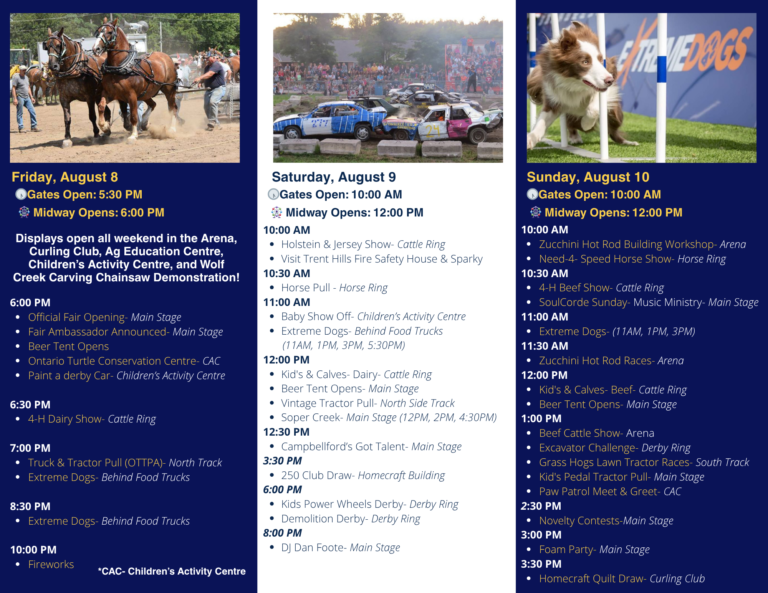
UPCOMING EVENTS
- July 12- Incredible Edibles
- August 8-10- Campbellford Fair
- October 24th- Pumpkinfest
- November 9th- Outdoor Christmas Market
SEE EVENT TAB FOR DETAILS
REFLECTIONS ON CAMPBELLFORD FAIR
By William (Bill) Petherick, July 2025
“Best fair in the world!”, my 7-year-old grandson Tal said when returning to our farm after spending a Saturday at the Campbellford fair several years ago while visiting from Calgary. When I asked him how he came to that conclusion he said: “The Calgary Stampede is too big and has long line-ups to get on a ride. At your fair, the rides are closer together and the lineups are shorter. All I did was go to the shortest line-up and soon I was riding and watching for my next best stop.” This routine likely would have lasted all afternoon, but his mother and sister Kayli insisted that they go to the children’s activities
nearby.
My first recollection of the Campbellford Fair was a little different than my grandson’s. It was 1940 and I was in Grade 1 at SS No 2 Seymour. My teacher, Miss Arkles, told us about meeting at the town school where we would be marching to the fair. The fair then was the last Tuesday and Wednesday of September. The older kids held a banner “SS No 2 Seymour” and the rest of us followed. Most of the other schools in the area took part in the parade. In the exhibit building (now called ‘the Red Barn’), each school had an area of about six feet wide to make a display, and I think there were prizes for the best ones.
These school displays were on the top storey of the building. There were also classes for high school art, shop work, home economics, and writing. In the building across the entrance road where the arena now sits, there were exhibits of garden produce, baking, canned goods, needlecraft, knitting, flowers, poultry, and a large cheese show. Beside the red barn was a large grandstand which could seat a big crowd watching horse races and horse classes held just inside the racetrack.
In 1947 at age 12, I joined the Campbellford 4-H Calf Club. Lindsay Anderson, our leader, picked me up and took me to monthly meetings where we learned how to feed our calf and keep records of costs, lead our calf in the ring (showmanship), clean and clip our calf for showing, and judge cattle and give reasons for placing, amongst many other skills. I paid particular attention to the three senior club members that year: Jean Rannie was President, Earle Nelson was Vice-President, and Bill Curle was Secretary and Press Reporter. Agriculture Representative from Brighton, Ralph Banbury, was present at most meetings and he was adamant that meetings be properly conducted, start on time, follow a written agenda with select time for new business, only one person talking at a time, and the meeting adjourned on time. Jean, Earle, and Bill were good at their jobs, and I later tried to do likewise in the 4-H Club. And in later life, I often remembered my early 4-H training on how to run a meeting! In 1952 at age 17, I had a very memorable year in 4-H. I had a good
calf that placed well, I won the showmanship class, had good marks in my reports, and was 1st in the local club overall. At the annual banquet sponsored by the Northumberland Holstein Club for all six calf clubs and the swine club in the county, I was surprised to win the gold watch from the Canadian Bank of Commerce for placing 1st in the county with 943 points out of 1000.
I have a copy of the prize list for the fair’s centennial year 1956. (Although the actual centennial anniversary was in 1954, for various reasons the celebrations weren’t held until 1956). Only people in my age bracket can remember the changes. There were classes for five breeds of dairy cattle, none for beef, five classes for cheese and two specials, horses alternated for judging between heavy and light classes in the ring in front of the grandstand, and there were also several heats of racing on the track. The horse pull had about 8-10 entries each in both light to heavy classes. The fair ended with a dance on Wednesday night.
The period between 1952 to 1967 saw many improvements to the fairgrounds: a new cattle barn was constructed using material from the Presbyterian church horse sheds, a new horse barn, steel pig and sheep pens, the Kinsmen Ball Park, and with Seymour Township, a large building to house township road equipment and to be used as a cattle barn at fair time. In 1967, the Campbellford-Seymour Community Centre was built, and the Campbellford Fair had the use of it for the fair which was moved to the second weekend in August and now qualified for “Class B status” which meant more government money was available to increase the prize money. The Northumberland Holstein Club decided to move its County show to Campbellford to take advantage of being able to hold the Black & White show inside at the township barn (and later in the arena after the curling club opened). This show was a big attraction for years and one of the biggest in the province with up to 20 exhibitors. The loss of so many dairy farms and robotic milking have greatly reduced both the size of the dairy shows and the number of spectators watching.
After my 4-H days ended in the early 1950s, I helped Dad, and my brother Eldon show our herd at Campbellford and other fairs. Dad had gone with Craig Nelson to a sale at Oakville and bought Craig’s heifer which turned out to be a “herd builder.” Three of her four calves graded Excellent and the bull “Almerson Sovereign Supreme” became a major reason for our herd improvement. When he was sold to the Quinte District artificial insemination unit, his offspring became popular in an even larger area! Craig Nelson’s herd had been dominant for several years and when our herd first won Premier Breeder & Exhibitor awards at the county Holstein show, he came over to our side of the cattle barn and congratulated us. Craig said, “I had an idea that heifer had a great future, but I didn’t expect her to come back to Northumberland!” The first year we showed at Campbellford, I stayed with the cows at night. Garnet Kerr was there with his Jerseys and Craig had stayed overnight also. It was cold that September night and I remember Garnet coming by in the middle of the night to see if I had enough covers. In the morning, Craig took Garnet and I downtown for breakfast.
And speaking of Craig Nelson, one day some years later, he asked me if I would sell passes at the northern gate on Saturday night and of course I said yes (and I had that job until I gave it up about 10 years ago when my legs wouldn’t stand it any longer). I knew
there was a ball league that played at the ballpark on Saturday night, and there had been a few problems before. The Fair board expected them to pay admission because some players had been seen at the midway and horse pull long after the ball game was over.
Clayton Thompson was looking after car 1, Craig Nelson at car 2, and I was approaching car 3 as it was entering off the county Road. Suddenly, there was a very loud conversation at car 1 and it wasn’t about the time of church the next morning. The driver had his arm out of the window and Clayton was pulling on his shirtsleeve! The driver put his foot on the gas, and the dust and gravel flew back at us as the car disappeared down the track! No harm was done but it could have been really ugly. I think the fair board made it a priority item
because there hasn’t been a ball game on fair night since!
When Lindsay Anderson retired from being 4-H Club Leader, I replaced him as Junior Leader. Earle Nelson and Eldon Petherick were Senior Club Leaders. With the County Holstein show on Friday night, the Campbellford 4-H Achievement Day on Saturday morning, the pre 4-H children’s show at noon, and the 4-H Show open to all Northumberland County clubs at 1 pm, the show ring was a busy place until sometimes 5 o’clock. Some judges work faster than others. For many years, the Northumberland Dairy Princess Contest was held on Saturday night in the same show ring, and it always drew a huge crowd.
In the fall of 1976, I decided to run for the local council as I had always been interested in a broader area of events and how tax money is spent in a municipality. In the fall of 1980, I became Reeve of Seymour, and my first public event was at the opening of the
Curling Club on the fairgrounds. It was funded 50% by a Wintario grant and the rest raised locally. Membership rose rapidly to a high of 430 in 1992. Finally, there was enough space for exhibits at fair time, meetings and banquets of all sorts, and an excellent kitchen to
work from. As Reeve I had the pleasure to bring greetings from council at fair openings for 22 years and although I know these things are sometimes boring and predictable, I always looked forward to them.
I was appointed to the committee for crops and seeds about 1985 and I had the pleasure to watch the judging one year. This was very educational, and I started to make a few entries from my own farm, Willipet Farms, with moderate success. I found out quickly
that the tallest corn doesn’t always get first prize, and the cob is the deciding factor.
There are many areas of the fair I have hardly mentioned. For example, the pigs, sheep, and poultry were important in the early years of the fair, but health regulations and lack of local breeders caused them to be taken off the prize list. Grant Forgrave was instrumental in reviving the poultry show for several years in the red barn. One class I remember was “best pair of geese” (1 male, 1 female). Gerald Fry, one of my public schoolmates, won the class, but I don’t remember what breed of geese they were. At the Royal Winter Fair that year, I went over to see the geese show and Gerald had again won “best pair of geese.” After that, some of us called him “The Goose King”!
As with everything else, fairs have had to change with the times. Beef cattle now are more numerous than dairy, so there are classes for several beef breeds. The highly competitive cheese show of the past is just a memory. The horse show was always interesting to watch. The 4 and 6 horse hitches with their polished harness and colourful wagons were real crowd pleasers, however I’m afraid we will have to go to the big fairs to see them in the future. To encourage attendance, demolition derbies, beer tents, bands, talent shows, tractor pulls, dog shows, lawn mower races, and even fireworks have become the norm, and the midways have also adjusted to meet the wishes of the fair goers.
I had sort of lost my enthusiasm for going out in the corn fields looking for the best 6 stalks of corn and sorting out the best hay so when Covid came, I figured I was done showing at the fair. Then I heard that a new class for ‘antiques and collectibles’ was starting, and a week before the fair, there were some old items appearing in my carport and backroom. I asked family members “Who’s showing these antiques? You must have a membership, fill out entry forms, and get them into the curling club either Thurs night or Fri morning before the Fair!” My daughters suggested that since I am ‘antique’, I should be the one to show them! Along with a few flowers that I enjoy looking after, I do think the antiques & collectibles class draws a lot of interest. And maybe my daughters were right: after showing calves, cows, corn and hay, attending fair openings, selling passes at the entrance gate, and being a 4-H leader, it was a good idea for the antique to show antiques.
I realize not everyone shares my decades long experience as a fair goer. But I encourage everyone to come to the fair. There is truly something for everyone from educational exhibits, fun on the midway, all kinds of food, animals, and fun activities and events on each day. But most of all, it is a wonderful opportunity to be part of a community event that has been going strong since 1854. Come see for yourself on August 8th -10th. After all, it is the ‘best fair in the world’!

